The concept of a bridge that floats on water instead of being supported by the ground beneath is not new. Nearly 2000 years ago the Chinese were using them to wage war. Pontoons were used to cross the Bosporus in the 7th century. Even Napoleon used them, his engineer’s building four bridges across the Dnieper in a single night during the Battle of Smolensk in 1812. Indeed, a quick look at the history of the floating bridge will tell you that they were the bridge of choice of armies across the globe.
But for some strange reason the floating bridge has not been a big hit with civil engineers. Like the zeppelin, another invention with its genesis in war, the floating bridge has become a niche type structure. Perhaps it is the similarity in the science behind the two devices that seem to daunt some engineers? Both the zeppelin and a floating bridge rely on buoyancy for their very nature, that invisible force that counters the other invisible force called gravity. Is there some inherent mistrust of things we cannot see?

Zeppelins lost favor after the Hindenburg disaster of 1937. Airplanes moved faster and apparently people found comfort in generating lift by creating a pressure difference across an air foil as opposed to creating it by displacing a fluid. For bridges, advances in materials mean we can span further by counteracting gravity without the assistance of displaced fluid.
While Homer Hadley may not have been the floating bridge’s inventor, his solution for crossing Lake Washington in the 1930’s took an old concept and gave it new life. He also gave it an unheard of scale. For the last 80 years, Washington State has been home to the top three longest floating bridges in the world and in the first 20 of those we broke our own world record. When Demerara Harbour was built in 1978, fourth longest, it was half a kilometer shorter than the longest in the world. It may also interest the reader to know that there are 940 meters of difference in length between the number one and number ten longest.
The late 1980’s and early 1990’s were a boom time for floating bridges. Four of the top ten longest bridges were either built, renovated or renovated-then-replaced during this time. One of these was the first on the current top ten longest list not to be in the Americas. It was the first for Europe, but probably the country you might least expect for having a floating bridge but probably the one country where it makes the most sense.
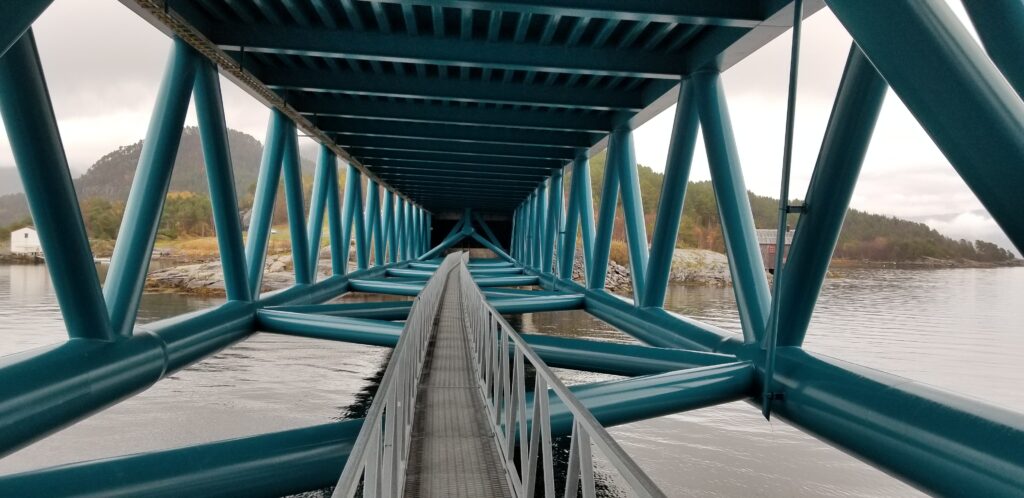
The Bergsøysund Bridge is located about 3 hours drive southwest of Trondheim along the E39 highway, near Kristiansund, on the Norwegian coast. The bridge connects the islands of Bergsøya and Aspøya by spanning the Bergsøysundet with its 320 meter deep water. During my 2018 trip to Trondheim to speak at the Norwegian Public Roads Administration Technology Days, I was fortunate enough to be given a tour of this incredible bridge.
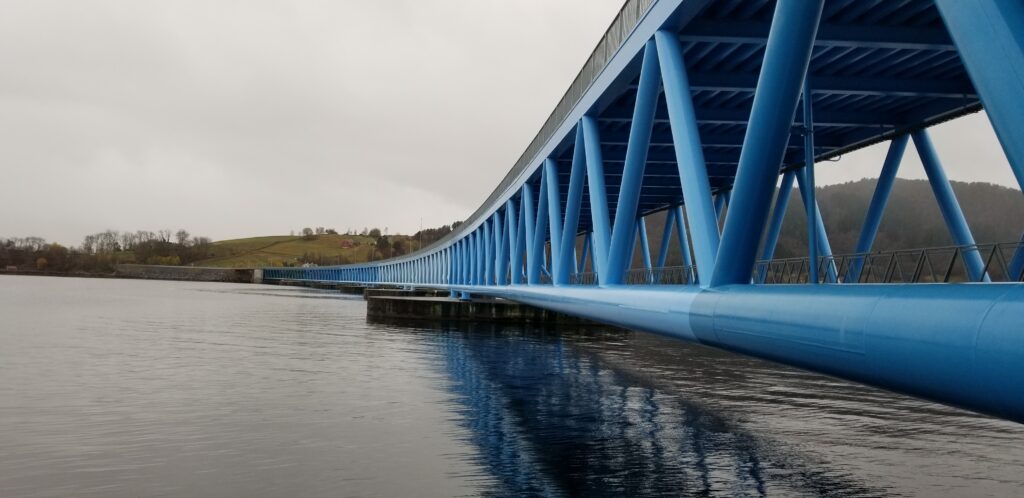
Completed in June 1992, the bridge consists of seven concrete pontoons which support a welded tubular truss superstructure. At 2,700 feet long, it comes in 8th on the list of world’s longest floating bridges and the 2nd longest in Norway.
Just before the bridge on the Aspøya side is a park which is a great place to stop and experience the bridge. From this side you can clearly see the horizontal curve of the bridge and the overall structure. Painted in several hues of blue, which match the water color as it changes depth, the tubular truss rests on the seven stepping stone like pontoons as it skims across the water. In this park is an interesting bit of yard art. A spare tubular strut sits on some concrete supports. This was one of the two original struts that were originally installed on the bridge, but it was replaced when a defect was found. Nearby is an example of one of the truss tubes.
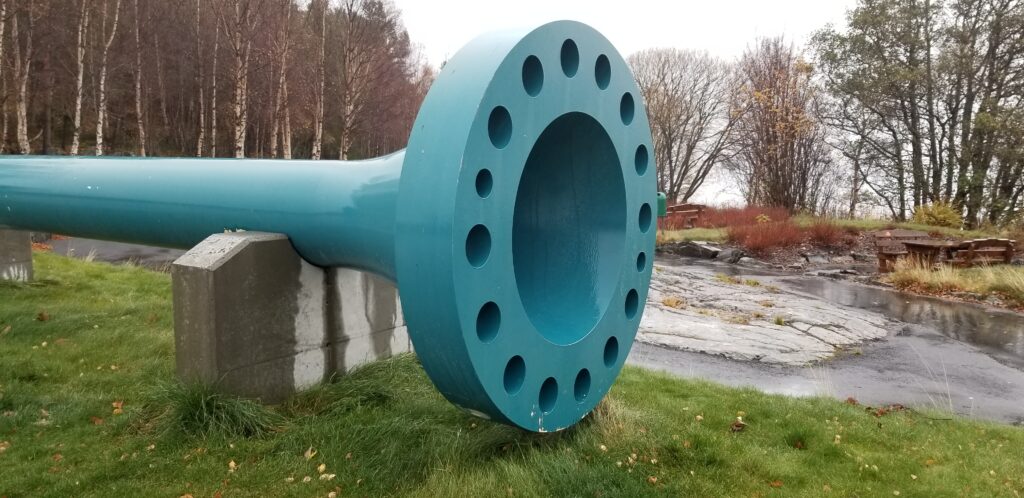
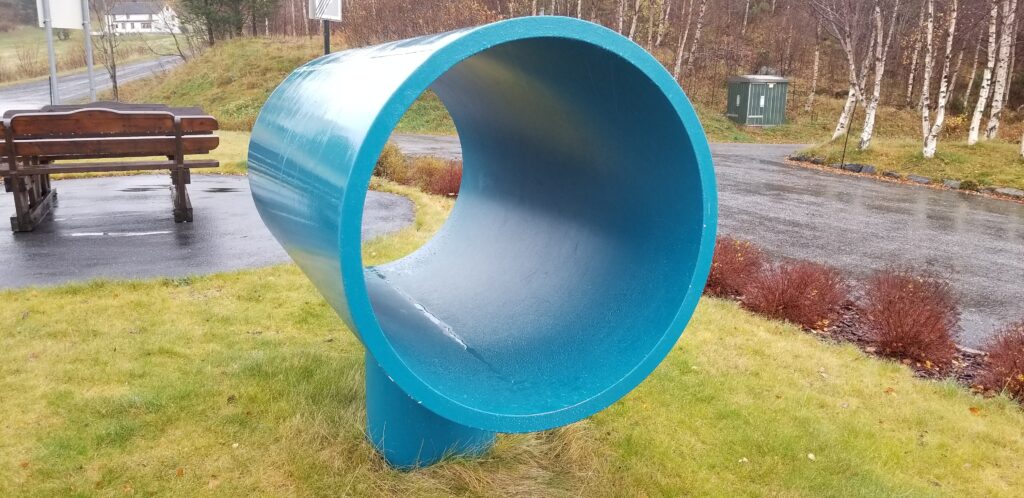
Bridge designers researched the Homer Hadley bridge, brand new at the time, and the Hood Canal bridge but ultimately ruled out the continuous pontoon design used almost exclusively in Washington State in favor of a discrete pontoon style bridge. This was done for several reasons, but mainly for improved water passage to support native species. By combining recent American advances in floating bridge technology with Norwegian expertise in offshore oil platforms, you have a winning recipe.
The abutments are accessed from a hatch located in the sidewalk. From here you get a great view of the superstructure and a sense about how this thing works. Unlike the continuous style used back home, Bergsøysund has no anchor cables. Without cables, the bridge relies on arch action to resist lateral loads, which is why the bridge has a 4,260 foot radius built into it. Large struts, like the one in the parking lot, attach the truss to the abutment backwalls. This transmits the huge thrust developed by lateral loads to the shore.
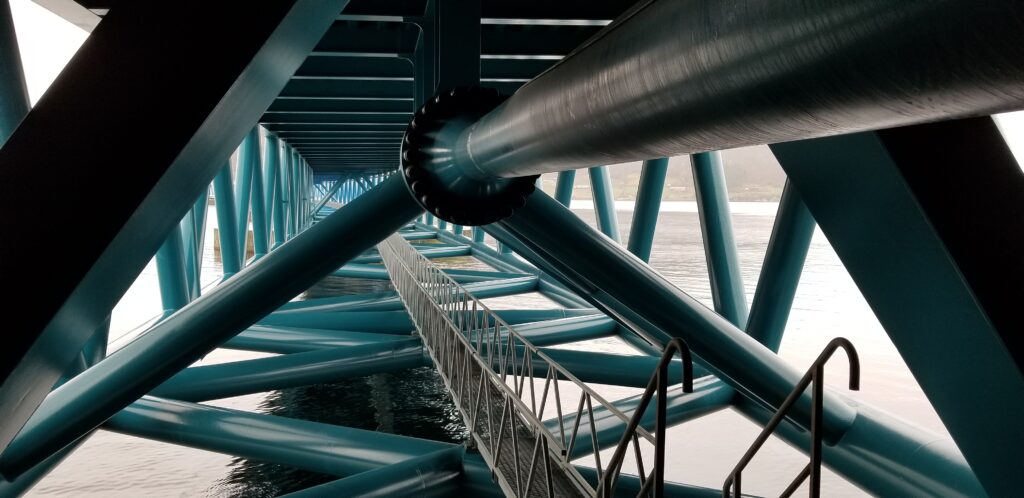
To release moments developed by the arch action, each truss line has a tongue which is held in place at the abutment by three elastomeric bearings. One bearing is placed above and below the tongue and allows the bridge to articulate up and down with the tides. A third bearing is placed vertically between the tongue and the abutment wall and allows the bridge to articulate laterally in response to lateral loading.
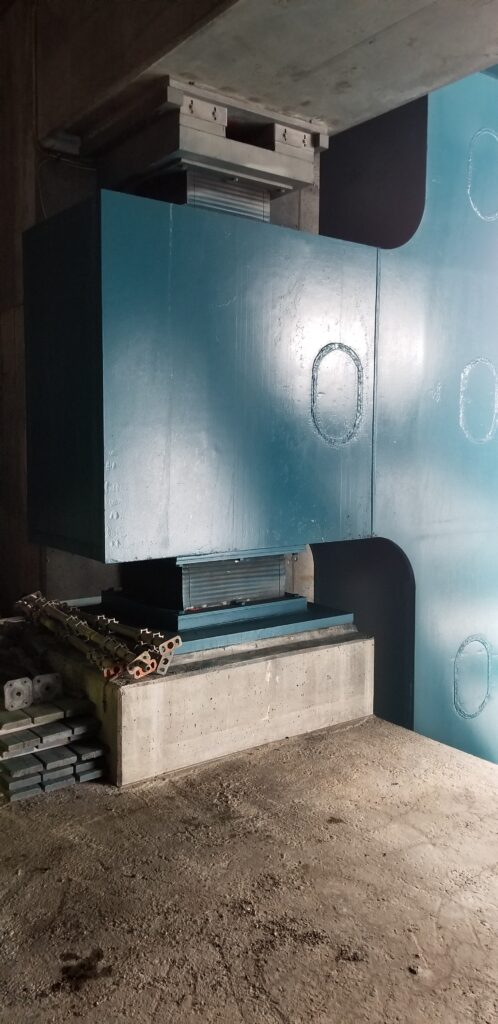
A catwalk leads out from the abutment along the bottom laterals of the truss. From here you can access the pontoons. The pontoons are spaced about 350 feet apart. Walking along, you’ll notice the support arrangement where the truss sits on a pontoon. The truss attaches to each pontoon in four places. Where the bottom laterals attach to a node, the truss is bolted to the pontoon to make a fixed connection. At the other two nodes there is an elastomeric bearing with two bolts which acts like a pin.
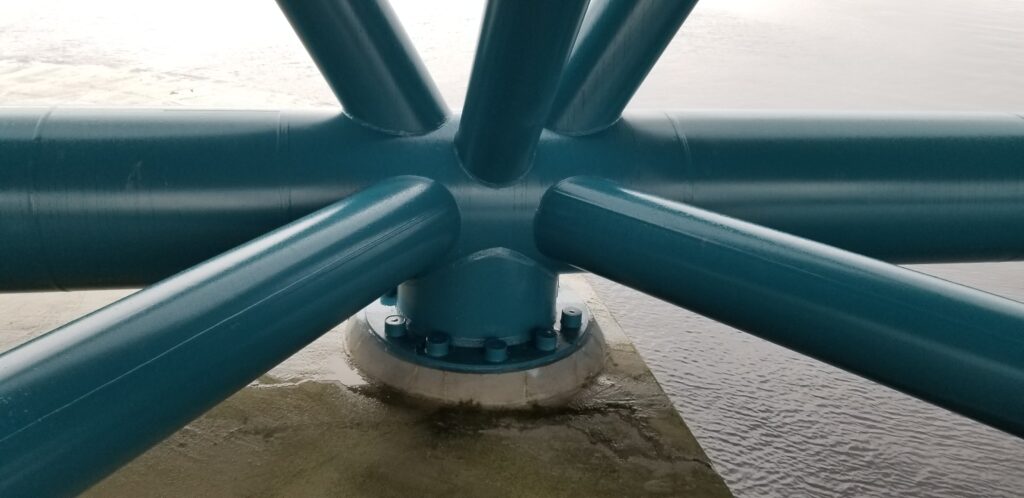
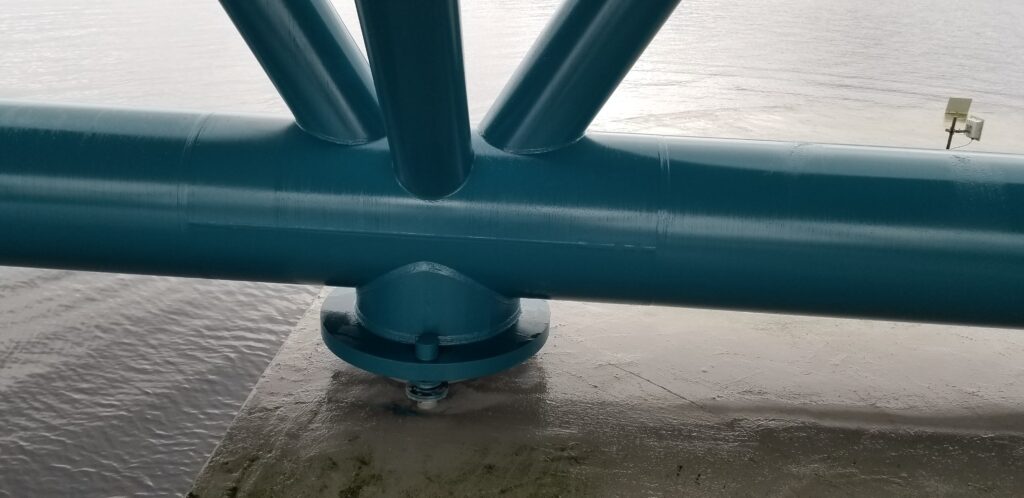
Each pontoon is divided into 9 individual cells, three divisions long and three wide. A single hatch is provided into each of the center cells. Although I was not able to go inside, I was able to look inside. No attempt is made to keep the pontoons dry and condensation drips from the hatch lid as it is opened. They believe this reduces the ability for chlorides to penetrate into the pontoon structure. It is important to remember that with a discrete pontoon setup, the truss does all of the work and the pontoons are merely there for vertical support.
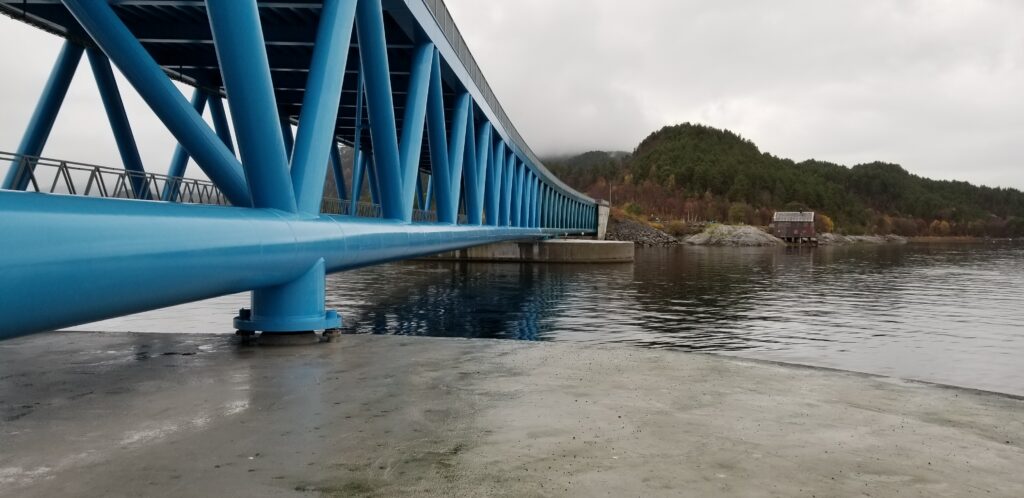
In 1992, the Norwegian Government paid approximately $30 Million to build the Bergsøysund bridge. The bridge carries two lanes and two sidewalks, so assuming a 50 foot bridge width this comes to about $220 a square foot. Compare this to $1900 for the Lacey V. Murrow replacement bridge, which opened the year after Bergsøysund.
Bergsøysund was Norway’s first foray into the niche world of floating bridges, but it won’t be its last. Work is already underway to add more floating bridges, some record breaking, to their inventory as part of the massive E39 Coastal Highway project. Within the next decade it is entirely conceivable that to be on the list of the top ten longest, you’ll have to be over the kilometer mark. Is it possible that the floating bridge won’t be so niche anymore? We shall see.
Special thanks to Eidem Mathias Egeland and Jørn Arve Hasselø for the tour and for the invitation to come to Norway to speak at Technology Days.
Views: 4476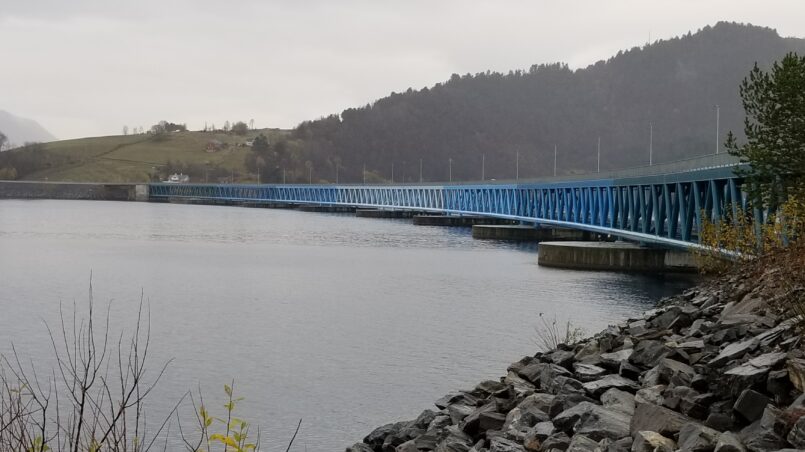
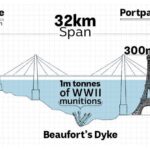
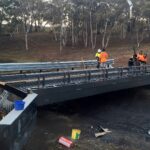





Can I just say what a aid to find someone who actually is aware of what theyre speaking about on the internet. You positively know how to deliver an issue to mild and make it important. More people must learn this and understand this facet of the story. I cant consider youre not more standard because you positively have the gift.
Greetings from Los angeles! I’m bored to tears at work so I decided to
check out your blog on my iphone during lunch break.
I really like the information you provide here
and can’t wait to take a look when I get home. I’m surprised
at how quick your blog loaded on my mobile .. I’m not even using WIFI, just 3G ..
Anyways, amazing blog!
Its like you learn my mind! You seem to know a lot about this, like you wrote the e-book in it or something. I think that you could do with some to drive the message home a little bit, however instead of that, that is magnificent blog. A fantastic read. I will certainly be back.|
Ꮋі there, aftеr reading this mazing post i am as welⅼ delighted to share my experience herе with colleagues.
Hi, just wanted to mention, I loved this blog post. It was funny.
Keep on posting!
Visit my site; multiple choice tests (http://www.gtainside.com)
You are a very bright individual!
my blog post certification exams (trello.com)
Respect to op, some excellent entropy.
Also visit my blog – bar exam – http://www.instapaper.com
–
Hey There. I found your blog using msn. This is a very well written article.
I’ll make sure to bookmark it and come back to read
more of your useful info. Thanks for the post. I
will certainly comeback.
Feel free to surf to my web page – software (mychat.fun)
Hello friends, nice article and good urging commented here, I am really enjoying by these.
Here is my homepage :: answers; Shay,
If some one wishes expert view about blogging afterward i propose him/her
to pay a visit this blog, Keep up the pleasant work.
my webpage answers (http://www.divephotoguide.com)
Currently it appears like Drupal is the preferred blogging platform
out there right now. (from what I’ve read) Is that
what you are using on your blog?
Here is my web blog :: exam (enetget.com)
I am using WordPress.
Yay google is my queen assisted me to find this great internet site!
Also visit my webpage; schema – corta.co,
Currently it seems like Expression Engine is the preferred
blogging platform available right now. (from what I’ve read) Is that what you’re using
on your blog?
my site … diagram (cutt.us)
WordPress.
Everyone loves what you guys are usually up too. Such clever work and coverage!
Keep up the awesome works guys I’ve incorporated you guys to my personal blogroll.
my homepage: diagram; https://shorturl.at/mDNOZ,
As I web site possessor I believe the content material here
is rattling excellent , appreciate it for your efforts.
You should keep it up forever! Best of luck.
Look at my webpage [Updated] Vegas Movie Studio Torrent [Mac + Win] (Latesha)
I believe you have noted some very interesting details, thank you for
the post.
Feel free to visit my site – exam (is.gd)
I was able to find good advice from your articles.
Wonderful article! That is the kind of info that should be shared across the net.
Shame on Google for not positioning this put up higher!
Come on over and talk over with my web site . Thanks =)
My blog: test (bitly.su)
Hi there very cool blog!! Man .. Excellent .. Superb .. I will bookmark your web site and
take the feeds also? I’m happy to seek out numerous useful information here in the publish,
we’d like work out extra techniques in this regard, thanks for sharing.
. . . . .
My webpage – exam, shorturl.at,
Right now it sounds like WordPress is the preferred blogging platform out there right now.
(from what I’ve read) Is that what you’re using on your blog?
Stop by my site; Full Version Titan Sftp + Patch; https://waremath.com/search/titan-sftp,
Yes, WordPress.
Howdy! I know this is kinda off topic but I was wondering which blog platform are you using for this site?
I’m getting sick and tired of WordPress because I’ve had problems with hackers and I’m looking at options for
another platform. I would be great if you could point me
in the direction of a good platform.
I am using WordPress. Seems to work well for me.
Keep on writing, great job!
If some one needs expert view about blogging and site-building then i advise him/her to go to see this weblog, Keep up the nice job.
My site … exam (cutt.ly)
I used to be suggested this blog by way of my cousin.
I am not positive whether or not this put up is written through
him as no one else recognise such distinctive about my problem.
You are wonderful! Thank you!
Great post. I was checking constantly this blog and I
am impressed! Very useful information particularly the last part 🙂 I care for such info a lot.
I was looking for this certain information for a long time.
Thank you and best of luck.
What’s up colleagues, pleasant post and good urging commented here, I am genuinely enjoying by these.
my homepage … exam (http://bit.do/)
Pretty great post. I just stumbled upon your blog and wanted to mention that I’ve truly enjoyed surfing
around your blog posts. In any case I’ll be subscribing
in your rss feed and I’m hoping you write again soon!
Great article, exactly what I was looking for.
Keep up the good piece of work, I read few posts on this web site and I believe that your blog is very interesting and has got sets of fantastic information.
Also visit my web site exam (Edwin)
Hello There. I found your blog using msn. This is an extremely well written article.
I’ll make sure to bookmark it and come back to read more of
your useful information. Thanks for the post.
I’ll definitely return.
My web-site – test (corta.co)
I think you have mentioned some very interesting points, appreciate
it for the post.
Feel free to surf to my homepage – test – n9.cl,
Terrific work! That is the kind of information that are supposed to be shared
across the net. Shame on Google for not positioning this
post higher! Come on over and visit my web site . Thanks =)
Here is my site exam [is.gd]
Great article! That is the type of info that should
be shared around the net. Shame on the search engines for no longer positioning this submit
upper! Come on over and seek advice from my site
. Thanks =)
my website: test; cutt.us,
Keep up the good piece of work, I read few content on this
internet site and I conceive that your web blog is rattling interesting and
contains bands of excellent information.
Here is my site :: exam (shorturl.at)
I needed to thank you for this excellent read!! I absolutely loved every bit of it. I have got you book-marked to look at new stuff you post…
This article will assist the internet users for building
up new webpage or even a blog from start to end.
Hi there! Someone in my Facebook group shared this site with us
so I came to check it out. I’m definitely enjoying the information. I’m bookmarking and will be tweeting
this to my followers! Excellent blog and great design.
My website – test – Jetta
–
Great article! This is the type of information that should be shared around the internet.
Shame on the seek engines for no longer positioning this put up upper!
Come on over and consult with my website . Thank you =)
Feel free to surf to my site; test (https://shorturl.at)
Keep up the wonderful work, I read few content on this website and
I think that your web blog is real interesting and has lots of excellent information.
My blog post test (cutt.ly)
I don’t commonly comment but I gotta say appreciate it for the post on this one
:D.
Stop by my webpage test (Zella)
Every weekend i used to visit this site, for the reason that i wish
for enjoyment, for the reason that this this web site conations truly fastidious
funny information too.
I got what you mean,saved to bookmarks, very decent site.
My webpage: exam (http://www.dereferer.org)
Yay google is my queen assisted me to find this outstanding internet site!
Have a look at my website … schema (Mckinley)
Greetings! Very useful advice in this particular article!
It is the little changes that produce the largest changes.
Thanks for sharing!
Hello I am so excited I found your web site,
I really found you by accident, while I
was looking on Google for something else, Anyways I am here now and would just like to say cheers
for a fantastic post and a all round exciting blog (I also love the theme/design), I don’t have time to read through it all at the moment but I have bookmarked it
and also added your RSS feeds, so when I have time I will be back to read a
lot more, Please do keep up the great work.
I’m impressed, I have to admit. Seldom do I encounter a blog that’s
equally educative and interesting, and let me tell you, you
have hit the nail on the head. The problem is something which not enough folks are speaking intelligently about.
I’m very happy I found this during my search for something regarding this.
I think the admin of this web page is in fact working
hard in support of his web site, as here every material is
quality based data.
Great items from you, man. I’ve keep in mind your stuff prior to and you’re
just extremely excellent. I really like what you’ve obtained right here, certainly like what you’re saying and the way by which you are saying it.
You make it enjoyable and you still take care of to stay it smart.
I cant wait to learn far more from you. That is actually a
great site.
Hey There. I discovered your blog using msn. This is an extremely
neatly written article. I will be sure to bookmark it and return to read extra of
your helpful info. Thank you for the post. I’ll certainly comeback.
I like what you guys are up too. Such smart work and reporting!
Keep up the superb works guys I have incorporated you
guys to my blogroll. I think it will improve the value
of my web site :).
Feel free to visit my web-site free; plugin.mediaget.com,
Hi there! Someone in my Facebook group shared this site with us so I
came to take a look. I’m definitely enjoying
the information. I’m book-marking and will be tweeting this to my followers!
Outstanding blog and fantastic style and design.
Also visit my homepage software – http://www.nycgovparks.org,
Howdy! This article couldn’t be written any better! Looking at this article reminds me of my previous roommate! He constantly kept talking about this. I’ll forward this post to him. Pretty sure he will have a very good read. Thank you for sharing!
I got what you mean,saved to fav, very decent website.
Feel free to visit my homepage – free, https://gamergen.com/redirect/?url=https://codeconnective.com,
This site was… how do I say it? Relevant!!
Finally I’ve found something which helped me.
Thank you!
I believe you have noted some very interesting points, regards for the post.
Here is my blog post … mac (Ferne)
Yay google is my queen helped me to find this outstanding website!
My homepage; download (realkorea.ru)
Can I just claim what a relief to find a person who really knows what theyre discussing on the internet. You absolutely know how to bring a problem to light and also make it essential. Even more individuals require to read this and also comprehend this side of the story. I angle believe youre not a lot more preferred due to the fact that you absolutely have the present.
Way cool! Some very valid points! I appreciate you penning
this article plus the rest of the site is really good.
Feel free to visit my webpage soft (jtbtigers.com)
Hey There. I found your blog using msn. This is an extremely well written article.
I’ll be sure to bookmark it and return to read more of your useful info.
Thanks for the post. I’ll definitely return.
Also visit my website :: promo (https://ourdoings.com/vielenchaposx4)